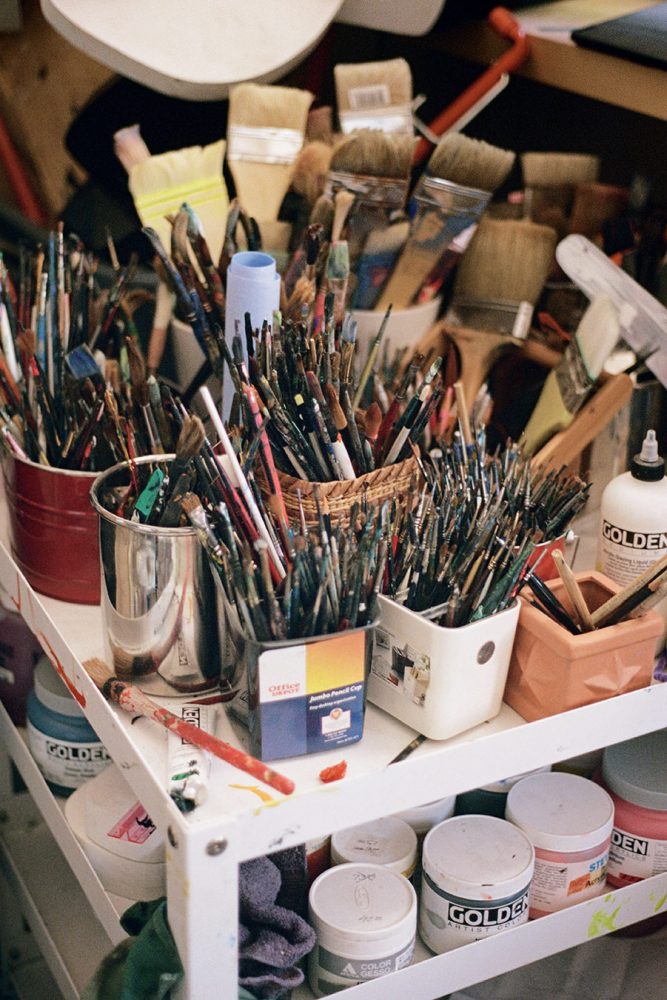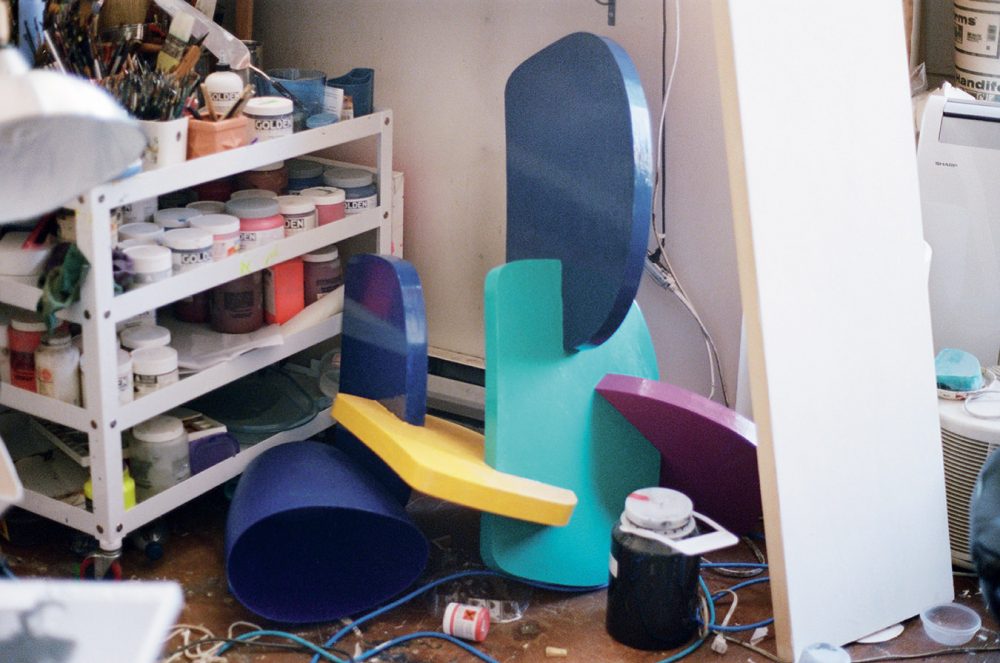Lawrence Paul Yuxweluptun spends up to 18 hours a day working on a painting. His narrow studio feels very much lived-in, with a kitchenette, a fish tank, photographs of his daughters, various bibelots. Hundreds of paintbrushes huddle together in assorted tin cans, and extension cords snake across the paint-flecked floor. There is a condor feather that no one is allowed to touch. “This place is always in a mess, but I get some of my best work done. The maid died,” Yuxweluptun says in jest, betraying his dark sense of humour.
He is quick to launch into a tirade about the issues that inflame him, many of which find expression in his large and vivid canvases. Yuxweluptun was born and raised in Kamloops, B.C. His mother was Okanagan and his father, Cowichan (part of the Coast Salish peoples); their forebears have inhabited the Pacific Northwest for over 10,000 years. Both parents fought hard for ancestral rights, and Yuxweluptun grew up immersed in the political and cultural struggles of First Nations people. In his youth, he was also acutely sensitive to the land he saw being continuously eroded by urban development and the reckless consumption of natural resources. These concerns of his formative years continue to influence Yuxweluptun’s work, and he is deeply unapologetic about his trenchant views. “If you’re on the other side of the fence, well I’m going to paint the other side of the fence,” he says.
For Yuxweluptun, his primary function as an artist is to record history and to provoke discussions that, however unpleasant, are utterly necessary. “Some things are really violent and it has to be recorded,” he says. “Do people want to go there? No. Do we need it? Yes. I think that if we censor ourselves, that’s a misfortune.”
Drawing from a broad art historical background acquired at Emily Carr College of Art, and his own affiliation with Coast Salish culture, Yuxweluptun has created an enduring position for himself within contemporary art discourse. He turns to consider a sizable work in progress. It’s in the inimitable style for which he is most widely recognized—brilliant hues and formal design elements from the Northwest Coast, all in a surrealist manner. Only two figures have been painted in amongst the sketch that suggests what the finished tableau will eventually look like: spirit dancers in the longhouse. Yuxweluptun gestures toward one of them. “What I’ve done is, I’ve taken tradition, and then I’ve morphed him from a human to a partial body of a bird—these symbolic claws, talons, then the bird head—an eagle. So he’s transforming,” he explains.
“The surrealists came to the Northwest Coast and studied what we were doing,” he says. André Breton, generally regarded as the founder of surrealism, was fascinated with art from the region and incorporated many pieces into his personal collection. “So [our work has] always been ‘surreal’. It’s just that I took it off the totem pole and put it into play. It’s fun to do, surrealism. But I’ve brought it into a different field of political satire, the environment. I think the surrealists were really safe. I think some of it was quite romantic.”
He has once said, “I try to make an ugly painting that is beautiful and I try to make a beautiful painting that has something ugly to say.” Indeed, much of Yuxweluptun’s work is an eloquent expression of his outrage at the blighted land. “You don’t have to go to the Amazon to see an aboriginal person standing in a clear-cut. We have some of the largest clear-cuts in the world here in British Columbia. I’ve stood in it and it is mind-boggling,” he says. As such, Yuxweluptun’s landscapes reference the tradition of Canadian landscape painting, but are stark, evocative, and depict a terrain fraught with conflict. In Scorched Earth, Clear Cut Logging on Native Sovereign Land, Shaman Coming to Fix (1991), the viewer is greeted immediately by amputated forms—tree stumps jut out from the bottom of the frame. The land stretches backward, denuded; the earth is parched. Mountains in the background are but a husk of their former selves, gutted and emptied out. A common thread in Yuxweluptun’s paintings, topographical elements are blanketed by adapted ovoids and formlines, which assert native rights to the land. A grim-faced shaman stands next to a crouched figure looking out at the denatured landscape in despair.
These paintings are Yuxweluptun’s premonitions for things to come, if we continue to exhaust our environment at the same impetuous pace. The initial sketch for another beautiful yet haunting work, Killer Whale Has a Vision and Comes to Talk to Me About Proximological Encroachments of Civilizations in the Oceans (2012), was made almost a decade ago. In this, an orca leaping out of the water toward a figure with outstretched arms is inhibited by a mucilaginous oil slick. When Yuxweluptun decided to bring the work into fruition, the BP oil spill in the Gulf of Mexico occurred days after he began painting. “If you can’t eat the fish, then there’s something wrong,” Yuxweluptun insists. “Do we need dioxins, do we need pulp mills to bleach our paper? Do we need bleached paper? Where do we start? How do we determine what is necessary? I don’t think I would eat anything out of the [Georgia] Strait anymore. That’s the reality of it. That’s why I paint. Somebody has to say this. It’s a dirty job and somebody has to do it.” He pauses. “If I had a radioactive Geiger counter, I would eat salmon,” he adds, issuing a deep belly laugh.
In 2000, Yuxweluptun began exploring more abstract forms in his work, and created a philosophy he called “ovoidism”. Floating freely across the canvas, yet engaged with each other, the ovoids suggest endless possibilities. And so, with ovoidism, Yuxweluptun is re-aligning tradition. “What I was doing is emancipating the ovoid in a modern term. Can you carve a delirious native in an intoxicated state of mind, traditionally, on a totem pole? How do you record a heroin addict? How do you record a sugar diabetic?” Yuxweluptun demands. “How am I going to record an existential thought? I think that’s why I created ovoidism—to free myself to express whatever I was thinking, feeling, or seeing. How do you deal with your own internal chaos? It’s not always a pretty carving or a pretty totem pole. Life is not always pretty.”
In works like Caution! You Are Entering A Free State of Mind Zone (2000), the ovoids, unencumbered by their traditional confines, are autonomous, charged, and very present forms. They are remarkably expressive. Rather than being flat shapes on the canvas, the ovoids are aroused by texture—movement is noticeable in the brushwork. They are also energized by his vivid use of colour, and his palettes are constantly changing. Reds, blues, and yellows sail in a graceful jumble across a navy blue canvas with one black, and one curious tint of green, ovoid. “The ovoidism is all about colour theory,” Yuxweluptun explains. “The intellectual process is a great exercise, but at the same time, I still like an issue. So I go, okay, let’s pick a really controversial topic and let’s try to create a painting that has an interesting colour theory. That’s why I created ovoidism—to interject things, life.”
Yuxweluptun’s most recent works have taken ovoidism from the canvas into the three-dimensional realm with new sculptural pieces. Wooden ovoids, painted in robust colours, come together in intriguing constellations—individual pieces are slotted together or positioned in a delicate, deliberate, and dynamic stack. Eschewing balance for tension, there’s a certain poise about these assemblages, yet the ovoids seem to be forever teetering on the brink of collapse. With these sculptures, Yuxweluptun is exploring yet another strategy for reconceptualizing complex thoughts, ideas, and emotions in an animate and dynamic way.
Underlying all of the work is a message, and this is what’s most significant for the artist. Dialogue is paramount. “I view the world, see things, experience them, and then I refract them back. They may teach you all the skills, but you have to have a conscious mind to think of what you’re going to say to the world,” Yuxweluptun says. “Either you create very beautiful, happy, intellectual, minimal art that is nice, corporate, schlocky, or you can make something that means something to somebody, and that will directly relate to their world, to their time. I get that. It gives them the insight, the direction, and the fortitude to go out and be what they want to be and think what they want to think. And that’s what makes culture move.”
For Yuxweluptun, it also seems that, for culture to progress, tradition must be constantly revisited and remade to reflect the present. “I think traditionalism is always going to be intact. There’s always going to be a carver. But I think the modern native is more attuned to the flux of change,” he says. Tradition must be treated inventively in order to remain relevant. As Russian literary critic Viktor Shklovsky wrote, “The purpose of the new form is not to express new content, but to change an old form which has lost its aesthetic quality.” And this is the crux of Yuxweluptun’s work. The expression of current and historic events, pre-existing ideas, and simple truths in an inventive and unfamiliar manner proposes a new way of seeing the world and thinking about real experiences. Yuxweluptun’s work brings us old ideas in a young body.












